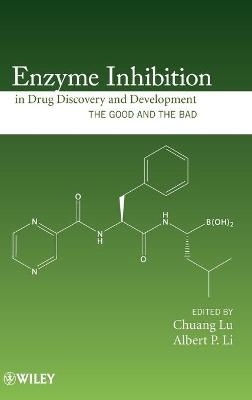
Enzyme Inhibition in Drug Discovery and Development
John Wiley & Sons Inc (Verlag)
978-0-470-28174-1 (ISBN)
The science and applied approaches of enzyme inhibition in drug discovery and development Offering a unique approach that includes both the pharmacologic and pharmaco-kinetic aspects of enzyme inhibition, Enzyme Inhibition in Drug Discovery and Development examines the scientific concepts and experimental approaches related to enzyme inhibition as applied in drug discovery and drug development.
With chapters written by over fifty leading experts in their fields, Enzyme Inhibition in Drug Discovery and Development fosters a cross-fertilization of pharmacology, drug metabolism, pharmacokinetics, and toxicology by understanding the "good" inhibitions—desirable pharmacological effects—and "bad" inhibitions—drug–drug interactions and toxicity. The book discusses:
The drug discovery process, including drug discovery strategy, medicinal chemistry, analytical chemistry, drug metabolism, pharmacokinetics, and safety biomarker assessment
The manipulations of drug metabolizing enzymes and transporters as well as the negative consequences, such as drug–drug interactions
The inhibition of several major drug target pathways, such as the GPCR pathway, the NFkB pathway, and the ion channel pathway
Through this focused, single-source reference on the fundamentals of drug discovery and development, researchers in drug metabolism and pharmacokinetics (DMPK) will learn and appreciate target biology in drug discovery; discovery biologists and medicinal chemists will also broaden their understanding of DMPK.
Chuang Lu, PhD, is the Associate Director in the Drug Safety and Disposition Department of Millennium Pharmaceuticals. His current research interests include drug-metabolizing enzymes, drug–drug interaction, and in vitro–in vivo correlation. Albert P. Li, PhD, is the President and CEO of In Vitro ADMET Laboratories, LLC and Advanced Pharmaceutical Sciences, Inc., and the cofounder, Chairman, and CSO of the ADMET Group. His experience spans over twenty-five years in the drug development industry, with over 150 publications. He is the editor of several books, including Drug–Drug Interactions in Pharmaceutical Development, published by Wiley.
PREFACE. CONTRIBUTORS.
PART I. DRUG DISCOVERY APPROACHES AND TECHNOLOGIES.
1. The Drug Discovery Process (Gerald T. Miwa).
2. Medicinal Chemistry of the Optimization of Enzyme Inhibitors (Geraldine Harriman, Amy Elder, and Indranath Ghosh).
3. Bioanalytical Technologies in Drug Discovery (Jing-Tao Wu).
4. Safety Biomarkers in Drug Development: Emerging Trends and Implications (Eric R. Fedyk).
5. The Role of Drug Metabolism in Drug Discovery (Tonika Bohnert and Liang-Shang Gan).
6. Applied Pharmacokinetics in Drug Discovery and Development (Hua Yang, Xingrong Liu, Anjaneya Chimalakonda, Zheng Lu, Cuiping Chen, Frank Lee, and Wen Chyi Shyu).
PART II. INHIBITION OF THE DRUG METABOLIZING ENZYMES—THE UNDESIRABLE INHIBITION.
7. Enzyme Inhibition and Inactivation: Cytochrome P450 Enzymes (R. Scott Obach).
8. Cytochrome P450 Induction (Edward L. LeCluyse, Michael W. Sinz, Nicola Hewitt, Stephen S. Ferguson, and Jasminder Sahi).
9. Inhibition of Drug-Metabolizing Enzymes in Gastrointestinal Tract and Its Influence on the Drug–Drug Interaction Prediction (Aleksandra Galetin and J. Brian Houston).
10. Enzyme Inhibition in Various In Vitro Systems (Ping Zhou).
11. Cytochrome P450 Degradation and Its Clinical Relevance (Mingxiang Liao, Ping Kang, Bernard P. Murray, and Maria Almira Correia).
12. Complexities of Working with UDP-Glucuronosyltransferases (UGTs): Focus on Enzyme Inhibition (Michael B. Fisher).
13. Evaluation of Inhibitors of Drug Metabolism in Human Hepatocytes (Albert P. Li and Chuang Lu).
14. Grapefruit Juice and Its Constituents as New Esterase Inhibitors (Suresh K. Balani).
15. Transporter–Xenobiotic Interactions: An Important Aspect of Drug Development Studies (Gang Luo, Richard Ridgewell, and Thomas Guenthner).
16. Polymorphisms of Drug Transporters and Their Clinical Implications (Cindy Q. Xia and Johnny J. Yang).
17. Clinical Drug Interactions Due to Metabolic Inhibition: Prediction, Assessment, and Interpretation (Lisa L. von Moltke and David J. Greenblatt).
18. Predicting Interindividual Variability of Metabolic Drug–Drug Interactions: Identifying the Causes and Accounting for Them Using Systems Approach (Amin Rostami-Hodjegan).
PART III. INHIBITION OF THE DRUG TARGET ENZYMES—THE DESIRABLE INHIBITION.
19. NF-κB: Mechanism, Tumor Biology, and Inhibitors (Lenny Dang).
20. G-Protein-Coupled Receptors as Drug Targets (Wenyan Miao and Lijun Wu).
21. Pharmacological Modulation of Ion Channels for the Treatment of Chronic Pain (Yi Liu and Ning Qin).
22. Targeting the mTOR Pathway for Tumor Therapeutics (Wei Chen).
23. HIV-1 Protease Inhibitors as Antiretroviral Agents (Sergei V. Gulnik, Elena Afonina, and Michael Eissenstat).
INDEX.
| Verlagsort | New York |
|---|---|
| Sprache | englisch |
| Maße | 163 x 243 mm |
| Gewicht | 1311 g |
| Einbandart | gebunden |
| Themenwelt | Medizin / Pharmazie ► Medizinische Fachgebiete ► Pharmakologie / Pharmakotherapie |
| Naturwissenschaften ► Chemie | |
| ISBN-10 | 0-470-28174-X / 047028174X |
| ISBN-13 | 978-0-470-28174-1 / 9780470281741 |
| Zustand | Neuware |
| Haben Sie eine Frage zum Produkt? |
aus dem Bereich


